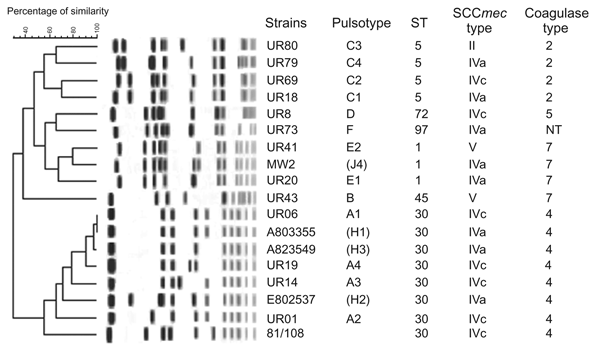Volume 11, Number 6—June 2005
Dispatch
Community-acquired Methicillin-resistant Staphylococcus aureus, Uruguay
Figure 2

Figure 2. . . Dendrogram of pulsed-field gel electrophoresis (PFGE) banding pattern of representative Uruguay clone. Pulsotypes of representative Uruguay strains, a CA-MRSA strain isolated in the United States (MW2), 3 CA-MRSA strains isolated in Australia (A803355, A823549, and E802537), and a Japanese strain isolated from an outpatient (81/108) were compared by using a BioNumerics software program (Applied Maths, Sint-Martens-Latem, Belgium). Similarity coefficient was calculated by using Pearson correlation with position tolerance of 5%, and cluster analysis was performed by the unweighted pair-group method. Pulsotypes in parentheses indicate the types previously reported (7). PFGE was performed for 22 h with a CHEF MAPPER (Bio-Rad, Hercules, CA, USA) with a pulse time of 5 s to 40 s. SmaI-restriction patterns of the tested strains and reference strains were compared by using BioNumerics software. Genotypes of representative strains were determined by multilocus sequence typing as described by Enright et al. (9). Sequence type (ST) and clonal complex were assigned using programs in the S. aureus multilocus sequence typing database (http://www.mlst.net).
References
- Eady EA, Cove JH. Staphylococcal resistance revisited: community-acquired methicillin resistant Staphylococcus aureus—an emerging problem for the management of skin and soft tissue infections. Curr Opin Infect Dis. 2003;16:103–24. DOIPubMedGoogle Scholar
- Galiana VA. Infecciones por Staphylococcus aureus adquiridos en la comunidad. Arch Pediatr Urug. 2003;74:26–9.
- Annual report: National Committee of Hospital Infection Control. Montevideo, Uruguay: Ministry of Public Health; 2001.
- Gorak EJ, Yamada SM, Brown JD. Community-acquired methicillin-resistant Staphylococcus aureus in hospitalized adults and children without known risk factors. Clin Infect Dis. 1999;29:797–800. DOIPubMedGoogle Scholar
- Shopsin B, Mathema B, Martinez J, Ha E, Campo ML, Fierman A, Prevalence of methicillin-resistant and methicillin-susceptible Staphylococcus aureus in the community. J Infect Dis. 2000;182:359–62. DOIPubMedGoogle Scholar
- Ma XX, Ito T, Tiensasitorn C, Jamklang M, Chongtrakool P, Boyle-Vavra S, Novel type of staphylococcal cassette chromosome mec identified in community-acquired methicillin-resistant Staphylococcus aureus strains. Antimicrob Agents Chemother. 2002;46:1147–52. DOIPubMedGoogle Scholar
- Okuma K, Iwakawa K, Turnidge JD, Grubb WB, Bell JM, O'Brien FG, Dissemination of new methicillin-resistant Staphylococcus aureus clones in the community. J Clin Microbiol. 2002;40:4289–94. DOIPubMedGoogle Scholar
- Ito T, Ma XX, Takeuchi F, Okuma K, Yuzawa H, Hiramatsu K. Novel type V staphylococcal cassette chromosome mec driven by a novel cassette chromosome recombinase, ccrC. Antimicrob Agents Chemother. 2004;48:2637–51. DOIPubMedGoogle Scholar
- Enright MC, Day NP, Davies CE, Peacock SJ, Spratt BG. Multilocus sequence typing for characterization of methicillin- resistant and methicillin-susceptible clones of Staphylococcus aureus. J Clin Microbiol. 2000;38:1008–15.PubMedGoogle Scholar
- Mowszowicz M, Pedreira W, Galiana A, Hiramatsu K, Ma XX, Ito T, Efficacy of co-trimoxazole–high dosage short course (SXT-HDSC) in community-acquired methicillin-resistant Staphylococcus aureus (CA-MRSA) outbreak in Uruguay jails 2003. Int J Infect Dis. 2004;8(Suppl 1):185.
- Baba T, Takeuchi F, Kuroda M, Yuzawa H, Aoki K, Oguchi A, Genome and virulence determinants of high virulence community-acquired MRSA. Lancet. 2002;359:1819–27. DOIPubMedGoogle Scholar
- Gillet Y, Issartel B, Vanhems P, Fournet JC, Lina G, Bes M, Association between Staphylococcus aureus strains carrying gene for Panton-Valentine leukocidin and highly lethal necrotising pneumonia in young immunocompetent patients. Lancet. 2002;359:753–9. DOIPubMedGoogle Scholar
- Diep BA, Sensabaugh GF, Somboona NS, Carleton HA, Perdreau-Remington F. Widespread skin and soft-tissue infections due to two methicillin-resistant Staphylococcus aureus strains harboring the genes for Panton-Valentine leucocidin. J Clin Microbiol. 2004;42:2080–4. DOIPubMedGoogle Scholar
- Hiramatsu K, Cui L, Kuroda M, Ito T. The emergence and evolution of methicillin-resistant Staphylococcus aureus. Trends Microbiol. 2001;9:486–93. DOIPubMedGoogle Scholar
- Ito T, Okuma K, Ma XX, Yuzawa H, Hiramatsu K. Insights on antibiotic resistance of Staphylococcus aureus from its whole genome: genomic island SCC. Drug Resist Updat. 2003;6:41–52. DOIPubMedGoogle Scholar